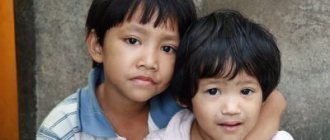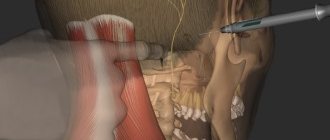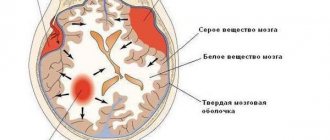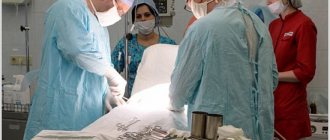According to statistics, 2% of parents experience apnea in newborns - a disorder in which the baby stops breathing for 20 seconds or more. Apnea occurs more often in premature babies. According to various estimates, from a quarter to a half of babies born at 37-42 weeks suffer from OSA (obstructive sleep apnea syndrome).
Norm
Uneven breathing in newborns during sleep is not always a problem. Parents should not worry if breathing stops:
- occur no more than once per hour;
- breathing in a sleeping child does not cause effort;
- the baby breathes evenly and deeply during sleep;
- holding your breath for less than 5 seconds;
- the baby’s heart does not slow down, the pulse does not subside, the skin does not change color.
If your baby’s breathing causes concern, you should find time and visit a pediatric somnologist – a doctor who treats sleep disorders.
Inhale-exhale
Before starting to fight apnea, pediatricians recommend familiarizing yourself with the types of breathing in newborns. After all, even such a universal process occurs differently for each child and can be characterized by different dynamics, rhythm and tempo.
There are 4 types of breathing:
- regular – characterized by a stable supply of air with equal intervals between inhalations and exhalations;
- irregular – interrupted and instability of the respiratory system is observed, expressed in unequal time intervals;
- periodic – interruptions are typical, as well as a change from increased breathing to weakened breathing; such attacks occur alternately with an interval of up to 3 seconds;
- pronounced apnea is the most dangerous type of breathing, requiring constant monitoring, since there may be no air absorption for up to 10–15 seconds.
Blockage of the airway causes the baby's fourth type of breathing. And the signal from the central nervous system to the respiratory tract may also stop. In addition to the lack of breathing, this phenomenon is characterized by bradycardia, when the myocardium contracts to 60 beats per minute.
This diagnosis is scary because prolonged cessation of breathing can lead to death. And parents can only find out about what happened the next morning, because in most cases there are no characteristic sounds. But there are also cases when you can hear disruptions in the child’s breathing, and if this has already happened before, from now on you need to be very careful and try to spend more time at the crib.
Kinds
Infant apnea - what is it? Experts distinguish several types of this pathology.
A baby born at term may experience the following types of apnea:
- central – short-term cessation of breathing, which occurs involuntarily in infants;
- obstructive - the child stops breathing due to obstruction (blockage) of the airways.
Premature newborns may experience:
- primary apnea - observed due to difficulty in lung function immediately after the baby is born or 3-6 months after birth;
- secondary – respiratory arrest after primary ventilation.
Secondary apnea is characterized not only by cessation of breathing, but also by a decrease in pressure and a general weakening of muscle tone. This condition can provoke the further development of complications.
Symptoms
The main alarm signal is interruptions in breathing or stopping it for more than 20 seconds. You should urgently make an appointment with a doctor if your breathing pattern does not fit into the norm, and if at least one of the following symptoms is observed:
- baby's skin becomes paler or bluer;
- cyanosis appears in the mouth and nose area due to oxygen deficiency;
- snoring (indicates an obstructive type of apnea);
- The baby suffers from restless sleep not for the first night;
- enuresis (indicates disruptions in the functions of the central nervous system);
- profuse sweating occurs during sleep;
- the child convulsively gasps for air, constantly breathes through his mouth (both in sleep and while awake);
- cannot restore smooth breathing after an attack.
Due to constant lack of sleep, the baby becomes capricious, constantly cries, and gets irritated.
The main symptoms of apnea in children born prematurely include:
- episodic interruption of breathing with pauses of 20 seconds or more;
- blue/pale skin;
- slowing of the pulse (in infants it can be heard more clearly on the shoulder or fontanelle).
Doctors are well aware of when apnea in premature babies goes away, unless there are complicating factors. This occurs by 40-45 weeks of life as the nervous and respiratory systems, as well as the respiratory control center, are finally formed.
It is more difficult to understand until what age the problem will last. Seizures can occur both in infants in the first weeks of life and in children older than six months. The prognosis is given only after a complete diagnosis.
Characteristic signs or how to recognize apnea
Often, young parents confuse apnea with periodic breathing and sound the alarm in advance. In order not to waste your energy and nerves in vain, it is better to familiarize yourself with the typical symptoms of apnea:
- Respiratory movements are not observed (the chest does not move, as happens during normal breathing).
- Bradycardia, i.e., a decrease in heart rate to below 100 beats.
- The skin around the nose and lips takes on a bluish tint.
- The predominance of breathing through the mouth, when the child tries to “catch” air that is not sufficiently supplied through the nose.
- Trouble swallowing, which may be due to a partially blocked airway.
- Sweating.
- Unusual body position during sleep. Thus, the child tries to take a more comfortable position, which compensates for the insufficient amount of incoming air while lying on his back.
There is also obstructive sleep apnea syndrome, which is characterized by unusual symptoms in the form of whistling, noises during breathing and sounds similar to snoring. It is observed in both newborns and older children who are already 2 years old. Complications can be caused by tonsillitis or lymphoid hypertrophy.
Causes and consequences
In newborns, pathology can develop due to problems:
- with lungs or heart;
- due to disorders of the respiratory functions of the central nervous system;
- due to airway obstruction.
In premature babies, the syndrome often develops due to an immature nervous system. The reasons may also be:
- unsuccessful ventilation after primary apnea;
- birth injury;
- congenital pathologies of the heart and blood vessels;
- intrauterine infections affecting the fetal brain;
- immaturity of the laryngeal muscles;
- craniofacial pathologies;
- weak muscular corset of the upper respiratory tract.
In addition, apnea is often a complication of hereditary diseases, as well as diseases that the child has already had - meningitis, inflammation of the adenoids, asphyxia, oxygen starvation, etc.
Breathing problems are extremely dangerous for the baby's health. They can also threaten his life. When breathing stops for 20 seconds, neurons begin to die. With a longer absence of oxygen, irreversible problems begin with all vital organs - heart, lungs, bronchi.
In children older than six months, neurological problems develop with chronic apnea. The child cannot concentrate. Memory deteriorates. With hyperactivity, it is extremely difficult for a child to find contact with other children. There are problems with socialization on the playground or in the nursery.
How and why does apnea appear in children after one year?
OSA in children after one year is caused by a physical obstruction of any kind that impedes the movement of air through the airways. Common causes of obstruction: infectious diseases of the ear, nose and throat. We are talking about enlarged, inflamed pharyngeal tonsils that interfere with the movement of air
- Children with inflamed adenoids are also susceptible to problems.
- Children after one year of age, who often suffer from respiratory infectious diseases, also suffer from apnea
Diagnostics
Sleep apnea is not a death sentence, and to understand how to treat it, it is enough to consult a doctor. Parents of a premature baby should make an appointment with a neonatologist. The rest go to a pediatrician, who will refer you to a specialist. The task of the otolaryngologist, neurologist, pulmonologist, cardiologist will be to identify the causes that provoked the disorders.
In newborns
Polysomnography is the main method that helps to identify pathology in children born at term. Diagnosis is carried out during sleep. Electrodes and sensors are connected to the baby’s body, which record the functioning of the respiratory system. The doctor visually monitors breathing pauses, their number, frequency and duration.
Additional examinations are carried out to identify the causes. For example, if you suspect:
- For obstructive apnea, anterior rhinoscopy is prescribed, which makes it possible to detect the causes of complicated nasal breathing;
- for disturbances in the functioning of the heart - ECG, ultrasound of the heart and brain;
- for pneumonia - radiography.
The doctor may also prescribe an MRI, CT scan, brain encephalogram and other examinations.
In premature babies
Most often, premature babies suffer from central apnea. Therefore, neurosonography becomes the main diagnostic method. Otherwise - ultrasound examination of the brain. The brain stem, where the respiratory center is located, is especially carefully studied. The doctor analyzes the nature and dynamics of brain processes and makes a conclusion about the presence or absence of pathologies.
If abnormalities are detected, a lumbar puncture is prescribed. With its help, they look for hemorrhages or inflammation in the brain.
How does this happen
As a rule, sleep apnea in adults is associated with snoring: a person snores evenly for some time, then there is silence, lasting about 5-10 seconds, followed by a loud snore, and the sleeper begins to toss and turn restlessly. During a night's sleep, some patients have up to two hundred such stops. As a rule, a person with apnea is unaware of his condition or considers it normal.
However, regular breath holdings do not pass without a trace, because at this time the body does not receive the oxygen it needs. The brain suffers the most, but oxygen starvation also negatively affects the functioning of the heart.
What to do for apnea: first aid
During an attack, parents should provide first aid to the baby by following simple steps:
- Take the baby in your arms, stroke or pat him on the back, rub his arms, legs, earlobes, tickle his heels or pat them.
- Spray your baby with cool water.
- To make breathing easier, place your baby on his tummy with his head turned to the side.
If the baby's breathing has not returned, perform artificial respiration:
- Place your baby on a hard surface on his back.
- Place a cushion from a sheet or towel under the shoulder blades so that the head tilts back slightly.
- Hold your head and inhale air into your mouth and nose at the same time. The air portions should be very small.
- If the child does not wake up after 6-8 breaths, perform chest compressions.
First aid
Sleep apnea in children is a serious condition, and to avoid worsening the child's condition, parents should be familiar with first aid techniques. It involves reproducing the following manipulations:
- record the time of the onset of the attack, while simultaneously picking up the child;
- start to gently shake the child, while simultaneously running your finger along the foot or spine (from bottom to top);
- rub the chest, ears, legs;
- Sprinkle a small amount of cool water on the child;
- If all of the above methods fail, start artificial respiration. Here it is important to take into account the fact that the volume of an adult’s lungs is several times larger than that of a child’s, so it is important to calculate the volume of air so as not to harm the baby.
While the father or mother provides first aid, the second parent calls an ambulance.
Treatment
During hospitalization, doctors perform the necessary manipulations to stabilize the baby’s condition. Premature babies are placed in an incubator. If the attacks recur there, the child is connected to a ventilator.
Medication prescriptions and clinical recommendations are made taking into account the causes of the disease. For example, to treat infant apnea caused by excessively enlarged adenoids, an ENT specialist prescribes surgery to remove them.
Other risk groups
In one-year-old toddlers, literally any little thing can make breathing difficult and cause apnea. OSA and anatomical abnormalities provoke it. In this regard, children with:
- Chronic tonsillitis and enlarged adenoids
- Sore throat and runny nose
- Polyps and swelling of the nasopharynx
There is a high risk of developing apnea in one-year-old children:
- With accumulation of lymphatic tissue in the nasopharynx
- For Down syndrome
- With a deviated nasal septum
- For various abnormal processes in the area of the soft and hard palate
- If the nasopharynx and nasal passages are narrow from birth
- If the facial parts of the skull have an abnormal structure
Prevention
Simple recommendations will help prevent the development of apnea in infancy:
- it is necessary to regularly ventilate the room where the child sleeps;
- the air in the children's bedroom should not be excessively dry;
- Before going to bed, the child should not be overheated;
- bedding must be selected correctly: a hard thin mattress, a low pillow, pillow filling and blankets made from natural materials (filling made from natural bird feathers is not acceptable);
- It is prohibited to use aerosols (both household products and perfumes) near the baby;
- tobacco smoke is strictly prohibited.
To control a child's sleep in the first months of life, it is worth placing his crib in the parents' bedroom.
Advantages of treatment at the RebenOK clinic
If parents notice a child snoring during sleep, it is recommended to consult a specialist in pediatrics or otolaryngology. The RebenOK clinic employs doctors with extensive practical experience and high qualifications. If snoring is diagnosed in a child during sleep, then effective conservative or surgical treatment is prescribed.
The medical center provides a doctor home call service. A specialist will conduct an initial examination in conditions familiar to the child and, if necessary, invite the patient to the clinic for a comprehensive diagnosis.










